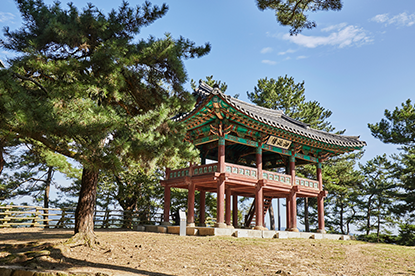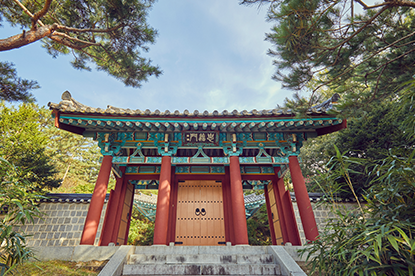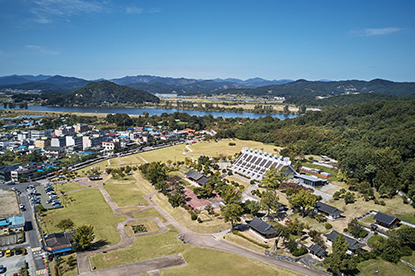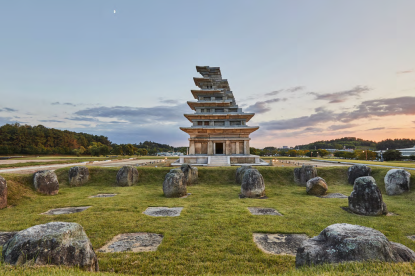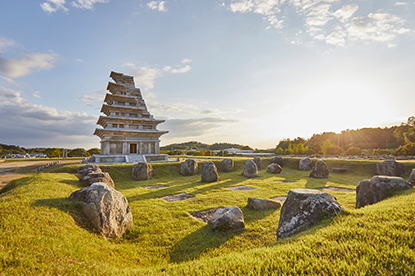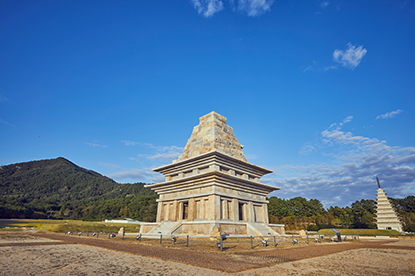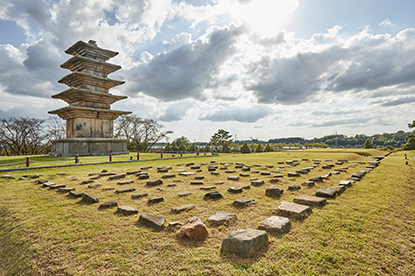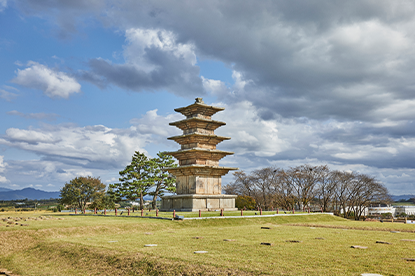Korean Heritage Passport Tour
- Incheon International Airport PR Center (Traveler Center)
- Gaya Culture Route
- Gwandong Pungryu Era Route
- Baekje Antiquity Route
- Korean Temple Monasteries (Sansa) Route
- Korean Confucian Academy Route
- Prehistoric Landscape Route
- Mythic Landscape Route
- Folk Music Route
- Royalty Route
- Golden Era Route
Gongju, Buyeo, Nonsan, Iksan - Beauty of Korea that resonates in your heart
Baekje, a kingdom that ruled the midwestern regions of the Korean Peninsula, used the Hangang River to set off to the sea. Being able to interact directly with neighboring countries meant that they were able to import foreign culture and technology faster than the other kingdoms in ancient Korea. Baekje took elements from more advanced cultures and molded them in their image to develop a sophisticated and beautiful culture, That culture then spilled over to other neighboring countries. This way, Baekje played a key role in the exchange and interaction of different peoples in ancient East Asia, and for a while, it seemed the kingdom would prosper forever. Unfortunately, after moving its capital three times, Baekje disappeared into the mists of history after 660 years. Today, only small fragments of this glorious ancient kingdom remain. But Gongju, Buyeo, and Iksan still have traces of Baekje’s advanced and elegant culture.

The best place to start your journey along the “Baekje Antiquity Route” is the city of Gongju. This is because Gonju offers plenty of convenient transportation options to other neighboring cities. You can get around Gongju by public transport, but if you want to visit Buyeo and Iksan, you would be better off driving. So, renting a car in Gongju could be a good idea. To go from Buyeo to Iksan on public transport, you need to transfer, preferably in Nonsan. If you do transfer via Nonsan, we recommend visiting the Donamseowon. (Intercity and intracity bus services are available between Buyeo and Nonsan; Once you arrive in Nonsan, you need to take a train to Iksan)
Gongju
The bravery of Baekje turns crisis into opportunityHanseong, the capital of Baekje, fell in 475 at the hands of King Jangsu of Goguryeo. Baekje, which had almost been annihilated from the invasion, moved its capital to Ungjin, the present-day Gongju area, which of course, is when the Ungjin era (475~538) of Baekje began. Although short-lived (only 64 years), Baekje rebuilt the country during the Ungjin era and resumed its trade with neighboring countries. Baekje showed its resilience as it blossomed in Ungjin, and Gongju still has places across the city that will remind you of its sparkling past.
Flavors of Gongju might just leave a lasting memory
-
Gongju Chestnuts
Gongju has been famous for its delicious chestnuts since ancient times. Farmers collect chestnuts once they have fallen from the tree, which is why they are much more robust and sweeter than chestnuts harvested from other regions. In Gongju, you will find chestnuts in a variety of dishes. One thing that might interest you is the sweet chestnut bread. So, try it if you visit Gongju.
-
Gongju Gukbap
Gukbap is one of the most common and popular foods in Korea. Gongju Gukbap is cooked with green onion and radish in meat broth that has a soothing, light, yet slightly sweet flavor. Usually, Gukbap is served with rice already mixed into the soup. But in Gongju, most restaurants serve the soup and rice separately.
Buyeo, Nonsan
Planned cities built by Baekje for its northward expansion and resurgenceBaekje, which managed to establish a stable foundation during its Ungin era, decided to relocate its capital to Sabi, which is the present-day Buyeo. The decision was driven to stimulate growth and improve governance across the entire kingdom. Given the rarity of a country moving its capital voluntarily, the move from Ungjin to Sabi in 538 CE (16th year of King Seong) was a monumental event. During the Sabi era (538~660), Baekje’s culture matured. Unfortunately, Baekje met its demise in Sabi, and the city of Buyeo today still has places that can remind you of the once-mighty kingdom’s downfall. Nonsan, a city that sits adjacent to Buyeo, was where the Battle of Hwangsanbeol, which was the final blow that brought Baekje to its knees, took place. On the fields of Hwangsanbeol, General Gyebaek (a symbol of patriotism for Baekje) met Silla forces for one final battle. Meanwhile, much later on, Nonsan became home to the Yehak school of Confucianism.
Flavors of Buyeo and Nonsan might just leave a lasting memory
-
Yeonnipbap
Yeonnipbap is steamed glutinous rice with dates, chestnuts, and pine nuts wrapped in clean lotus leaves. The lotus flower is a symbol of Buyeo, and since ancient times, the people of Buyeo have eaten Yeonnipbap with lotus leaves picked from Gungnamji Lake. As the signature dish of Buyeo, Yeonnipbap offers a great blend between the chewy glutinous rice and subtle lotus leaf aroma.
-
Yeonggotbbang
Yeonggotbbang is a type of bread made to look like a lotus-patterned roof tile from Baekje. It is made with lotus flowers and red bean paste, which gives it a soft texture and sweet flavor. Yeonggotbbang has a short shelf life as it does not contain any preservatives. The short shelf life, however, is worth it as the bread tastes healthy without preservatives.
-
Jeotgal
Locals are particularly skilled in making Jeotgal (salted seafood) dishes using traditional recipes handed down near the old Ganggyeong Port. Merchants sort through various seafood ingredients from different regions and choose the best to make and ferment Jeotgal products, which is why the Jeotgal here tastes delicious.
-
Strawberries
Thanks to its fertile soil, abundance of sunshine, and clean water, Nonsan produces 15% of all strawberries produced in Korea. Nonsan strawberries are known for their excellent flavor and aroma.
Iksan
Baekje’s newest city inspired by hopes of a new revivalSeodong, who lived in Iksan digging up and selling yam roots, became King Mu of Baekje (39th monarch of Baekje). King Mu spent his entire life recapturing territories lost to Silla and strengthening the authority of the throne, which had severely deteriorated before his reign. In doing so, King Mu believed Iksan was particularly important as a city. Today, you can find remains of a royal palace and a large temple in Iksan, which supports the theory that King Mu had plans to relocate to Iksan. This new city, created for a new resurgence of Baekje, represented King Mu's dream. Exploring Iksan and immersing yourself in that long-lost dream could prove an interesting journey.
Flavors of Iksan might just leave a lasting memory
-
Hwangdeung Bibimbap
Hwangdeung Bibimbap, along with Jeonju Bibimbap and Jinju Bibimbap, is considered one of the top-3 Bibimbaps in Korea. Originally sold in Hwangdeung market, Hwangdeung Bibimbap is served with rice warmed with what is known as the “Toryeom” technique. Toryeom involves pouring hot soup over rice several times, then pouring the soup away several times to warm the rice up. Hwangdeung Bibimbap is made with rice warmed using the Toryeom technique mixed with seasoning. Then, the dish is garnished with various vegetables or raw meat..
-
Seodong Ma
Ma (yam) from Iksan, famous for its excellent quality, is often called “Seodong Ma” thanks to the ancient tale of King Mu (Seodong) of Baekje, who used to sell Ma when he was young. Seodong Ma has a hard and dense texture, and is also rich in nutrients, which makes it a popular ingredient in a number of dishes. Aside from cooked dishes featuring the Seodong Ma, you can also enjoy processed foods such as rice Nurungji and noodles made with Sedong Ma.
Gongju
The bravery of Baekje turns crisis into opportunityHanseong, the capital of Baekje, fell in 475 at the hands of King Jangsu of Goguryeo. Baekje, which had almost been annihilated from the invasion, moved its capital to Ungjin, the present-day Gongju area, which of course, is when the Ungjin era (475~538) of Baekje began. Although short-lived (only 64 years), Baekje rebuilt the country during the Ungjin era and resumed its trade with neighboring countries. Baekje showed its resilience as it blossomed in Ungjin, and Gongju still has places across the city that will remind you of its sparkling past.
Korean Heritage festivals in Gongju
-
2023 World Heritage Festival (universal)
The World Heritage Festival is a major festival that gives visitors an opportunity to enjoy a variety of UNESCO World Heritage resources. The shining legacy of Baekje! Baekje Historic Area
For more details, please check the festival’s official website below.
Website www.worldheritage.modoo.at
-
Great Baekje Festival
As the ancient capitals of Baekje, Gongju-si and Buyeo-gun have hosted the Great Baekje Festival since 1955 to commemorate Baekje, which was a cultural powerhouse in ancient East Asia.
For more details, please check the festival’s official website below.
Website www.baekje.org
-
Geumgang Nature Art Biennale
Geumgang Nature Art Biennale is an international natural art exhibition featuring permanent outdoor exhibitions, nature art symposiums, nature art education programs, and video exhibitions.
For more details, please check the festival’s official website below.
Website www.natureartbiennale.org
Buyeo, Nonsan
Planned cities built by Baekje for its northward expansion and resurgenceBaekje, which managed to establish a stable foundation during its Ungin era, decided to relocate its capital to Sabi, which is the present-day Buyeo. The decision was driven to stimulate growth and improve governance across the entire kingdom. Given the rarity of a country moving its capital voluntarily, the move from Ungjin to Sabi in 538 CE (16th year of King Seong) was a monumental event. During the Sabi era (538~660), Baekje’s culture matured. Unfortunately, Baekje met its demise in Sabi, and the city of Buyeo today still has places that can remind you of the once-mighty kingdom’s downfall. Nonsan, a city that sits adjacent to Buyeo, was where the Battle of Hwangsanbeol, which was the final blow that brought Baekje to its knees, took place. On the fields of Hwangsanbeol, General Gyebaek (a symbol of patriotism for Baekje) met Silla forces for one final battle. Meanwhile, much later on, Nonsan became home to the Yehak school of Confucianism.
Korean Heritage festivals in Buyeo and Nonsan
-
Baekje Cultural Festival
The Baekje Cultural Festival is celebrating its 67th anniversary this year. As the ancient capitals of Baekje, Gongju-si and Buyeo-gun have hosted the Festival since 1955 to commemorate Baekje, which was a cultural powerhouse in ancient East Asia.
For more details, please check the festival’s official website below.
Website www.baekje.org
-
Baengmagang Moonlight Night Market
If you want to enjoy your midsummer night just a little longer, head over to the Baengmagang Moonlight Night Market. The Market has plenty of things to see and a variety of exotic foods prepared by multicultural families in Korea to make your night that much more memorable. Baengmagang Moonlight Night Market was inspired by the legend of Princess Seonhwa who was believed to have been the moon personified.
For more details, please check the festival’s official website below.
Website www.buyeonight.com
-
Busosan Spring Festival
Busosan Spring Festival is a spring-themed “healing” festival hosted at Busosanseong Fortress and the Gwanbuk-ri Ruins. Although small in scale, the Festival offers programs both online and in-person.
For more details, please check the festival’s official website below.
Website https://www.buyeo.go.kr/
-
Yeonsan Baekjungnori
Yeonsan Baekjungnori has been handed down in the Gojeong-ri, Yeonsan-myeon area in Nonsan. It was inspired by people visiting the tomb of Kim Guk-gwang, who had served as Jwaeuijeong during the reign of King Seongjong (1469-1494 CE) of the Joseon Dynasty, on the day of Baekjung to celebrate his life and achievements. Later, as the Kim clan from Gwangsan relocated to the Yeonsan area, they gathered at the Yeonsan Traditional Market to enjoy themselves with various forms of entertainment, and this eventually became the Yeonsan Baekjungnori we now know today.
For more details, please check the festival’s official website below.
Website https://www.nonsan.go.kr/
-
Reenactment of the Battle of Hwangsanbeol
The Reenactment of the Battle of Hwangsanbeol commemorates Gyebaek, the great general who commanded Baekje’s last army at Hwangsanbeol, and the Battle of Hwansanbeol where 5,000 warriors gave their lives to protect their beloved home and country. The event also features other interactive activities - you can make your own rice balls, make traditional rice cakes, eat field rations, and enjoy various cultural performances.
For more details, please check the festival’s official website below.
Website https://www.nonsan.go.kr/
-
Buyeo Korean Heritage Night
Buyeo Korean Heritage Night is a tourism program designed to highlight Buyeo’s local culture and heritage. It gives visitors a chance to engage in various historical and cultural activities in the evening with intriguing content from surrounding Korean Heritage sites, most notably the old relics of Jeongrimsa Temple which was originally built by Baekje.
For more details, please check the festival’s official website below.
Website https://www.buyeo.go.kr/
Iksan
Baekje’s newest city inspired by hopes of a new revivalSeodong, who lived in Iksan digging up and selling yam roots, became King Mu of Baekje (39th monarch of Baekje). King Mu spent his entire life recapturing territories lost to Silla and strengthening the authority of the throne, which had severely deteriorated before his reign. In doing so, King Mu believed Iksan was particularly important as a city. Today, you can find remains of a royal palace and a large temple in Iksan, which supports the theory that King Mu had plans to relocate to Iksan. This new city, created for a new resurgence of Baekje, represented King Mu's dream. Exploring Iksan and immersing yourself in that long-lost dream could prove an interesting journey.
Korean Heritage festivals in Iksan
-
Iksan Seodong Festival
Iksan Seodong Festival is the signature festival of Iksan that originally started out as the Mahan Folk Festival, which started back in 1969. It celebrates the beautiful love story between Sedong and Seonhwa that transcended borders with tourist attractions at the UNESCO World Heritage Baekje Historic Areas.
For more details, please check the festival’s official website below.
Website www.seodong.iksan.go.kr
-
Iksan Korean Heritage Night
Iksan Korean Heritage Night Trip will take you to the ancient ruins in Wanggung-ri, which is where King Mu had hoped to move Baekje’s capital and the Five-story Stone Pagoda (National Treasure No. 289). Iksan Korean Heritage Night begins when night falls and the ruins across Iksan come alive with history. Iksan Korean Heritage Night is the perfect midsummer night’s event that gives you a chance to immerse yourself in the glory of Baekje’s royal palace and World Heritages in Iksan.
For more details, please check the festival’s official website below.
Website www.iksan-night.kr
- Gongsanseong Fortress, Gongju
- Magoksa Temple, Gongju
- Donamseowon, Nonsan
- Naseong Fortress, Buyeo
- Busosanseong Fortress, Buyeo
- Mireuksa Temple Site, Iksan
- Archaeological Site in Wanggung-ri, Iksan
Gongsanseong Fortress in Gongju protected Ungjin, the new capital of Baekje
-
Address
280, Woongjin-ro, Gongju-si, Chungcheongnam-do
-
Inquiries
041-856-7700
-
Opening hours
09:00-18:00 (Closed on the day of Seollal and Chuseok)
-
Stamp
Tourist information center (stamp book), ticket office (stamp)
-
Admission
Adults KRW 1,200 / Teenagers KRW 800 / Children KRW 600
-
Directions
Take a bus bound for Gongju at the Seoul Express Bus Terminal → Get off at Gongju Bus Terminal → Take bus no. 200 at the Central Bus Terminal (to Yukryong-dong) bus stop → Get off at the Gongsanseong (Sanseong Market) bus stop → Walk for 9 minutes
Gongsanseong Fortress is a major fortress from the Baekje era, surrounded by mountains and valleys along the Geumgang River. It was originally built using compacted earth, but in the Joseon Dynasty, stone blocks were stacked on top of each other, turning it into a stone fortress. Early on in its life, Gongsanseong Fortress was called “Ungjinseong Fortress,” but it became known as Gongsanseong Fortress or “Gongjusanseong Fortress” since the Goryeo Dynasty. Gongsanseong Fortress, which did serve as the royal castle of Baekje until the capital was moved to Buyeo in 538 (the 16th year of King Seong), was a major hub for local administration until the Joseon Dynasty. In fact, archaeologists have discovered plenty of artifacts from the Goryeo and Joseon Dynasty periods in addition to tiles and earthenware from Baekje at Gongsanseong Fortress. The Fortress also appears in several landmark events in Korean history. Immediately after the fall of Baekje, King Uija stayed at Gongsanseong Fortress for a while, then it became a foothold for a local movement aimed at reviving the defunct kingdom of Baekje. During the Unified Silla period, Kim Heon-chang began his rebellion (822 CE) at Gongsanseong Fortress as well. Meanwhile, during the Joseon Dynasty, when Yi Gwal defied the throne with his own rebellion (1623 CE), King Injo was forced to take refuge at Gongsanseong Fortress for a while. The way the Fortress’ walls stretch boldly and powerfully along the ridge line is a reminder of Baekje’s brave and enterprising spirit. The structure that serves as the main gate to this imposing fortress is named Geumseoru. If you enter through the gate and take a walk around the Fortress, you can enjoy some interesting features inside the Fortress as well as a bird’s eye view of downtown Gongju. Particularly from the west gate, you will see the tombs of King Muryeong in Gongju and the Royal Tombs Park (tumuli in Songsan-ri, Gongju), religious relics from the Baekje period at Jeongjisan Mountain, and Gomanaru Port on the banks of Geumgang River off in the distance.
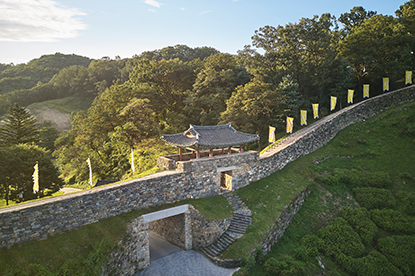
Provided by the Korea Korean Heritage Foundation
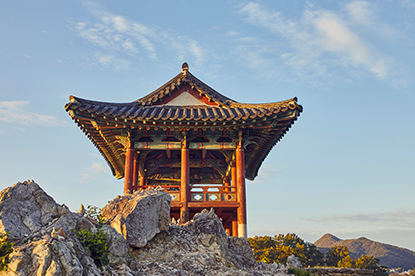
Provided by the Korea Korean Heritage Foundation
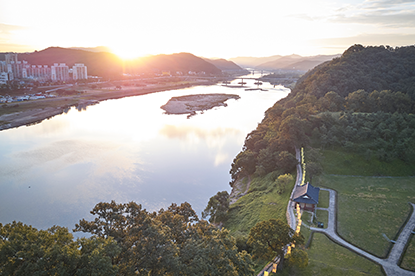
Provided by the Korea Korean Heritage Foundation
 Gongsanseong Fortress night view point
Gongsanseong Fortress night view point
At Geumgang Singwan Park, which is right across the Geumgang River from Gongsanseong Fortress, you can watch the Fortress glisten in the dark along the ridge line. During the Baekje Cultural Festival, you can actually walk across a floating bridge in front of Gongsanseong Fortress and head over to the Park.









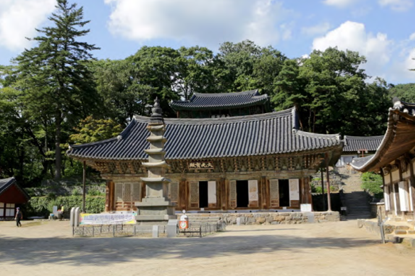
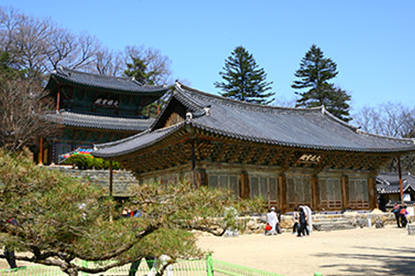
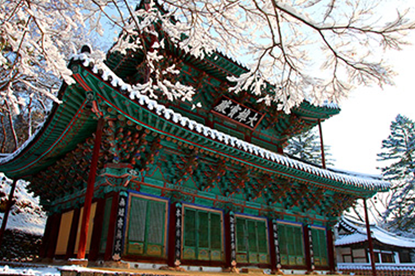
 Temple Stay program at Magoksa Temple, Gongju
Temple Stay program at Magoksa Temple, Gongju
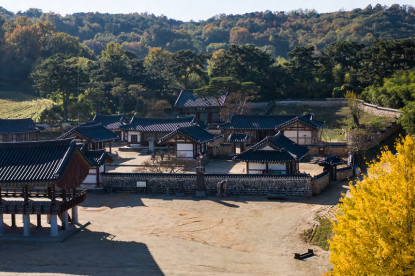
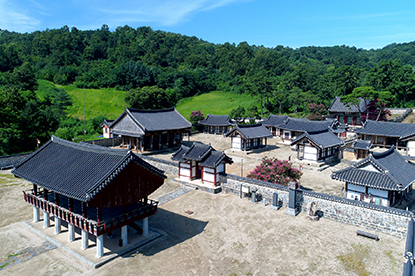
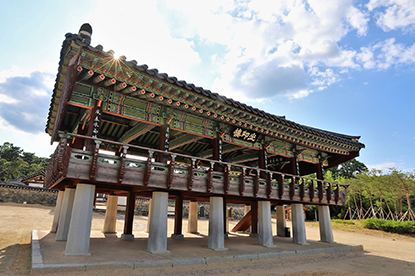
 Immersive programs at Donamseowon
Immersive programs at Donamseowon
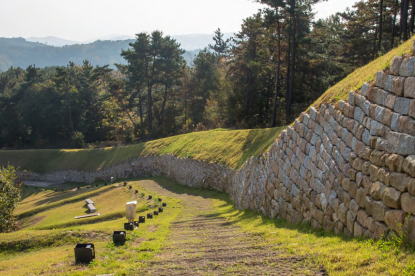
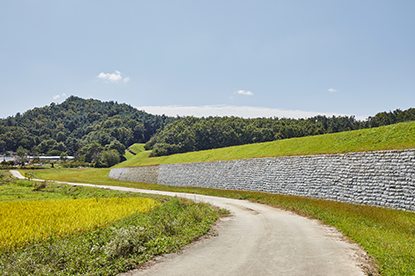
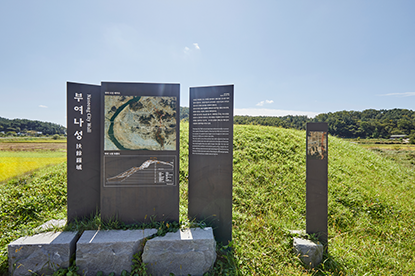
 Doseong, Naseong, and Sanseong Fortresses
Doseong, Naseong, and Sanseong Fortresses
